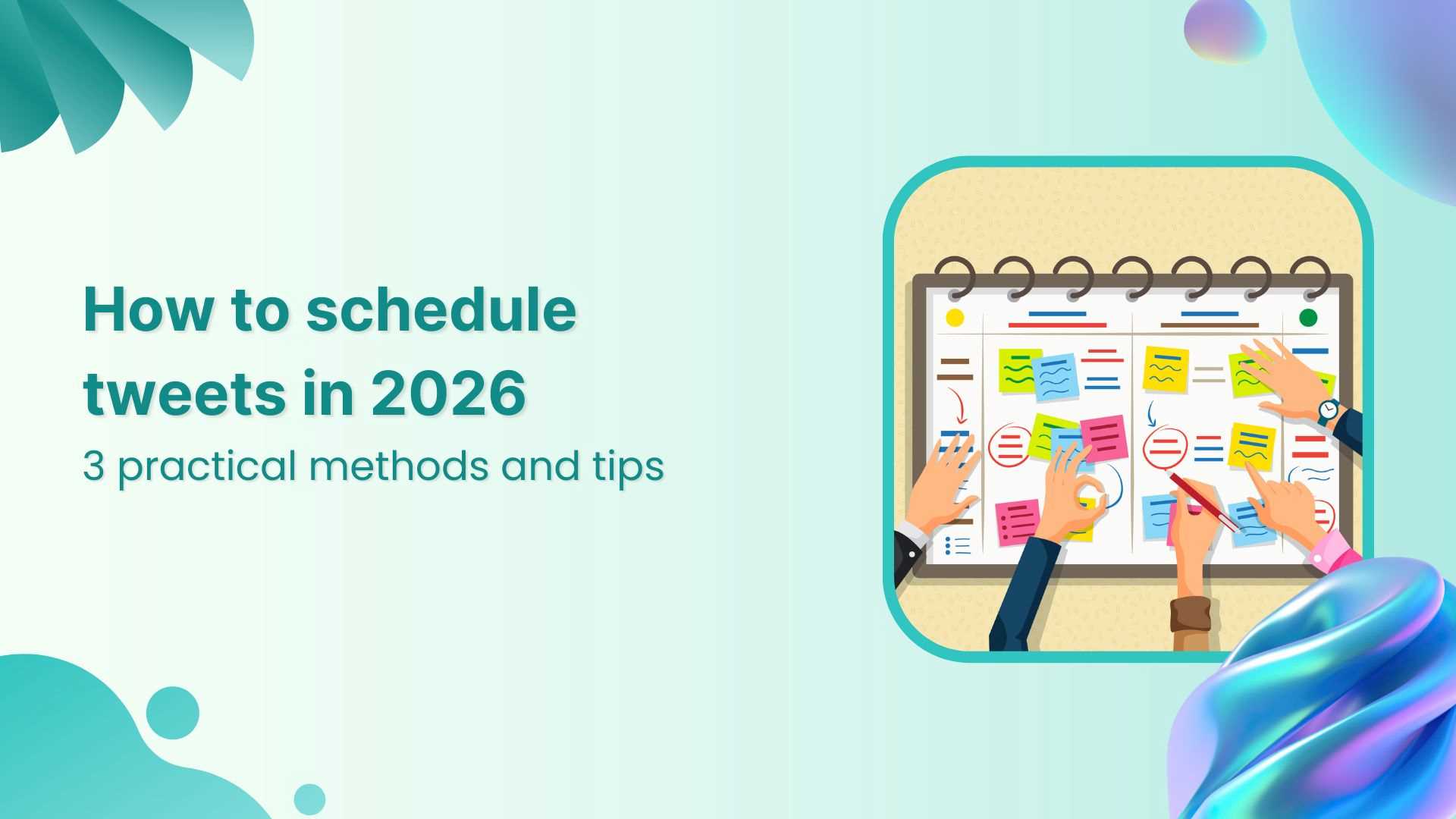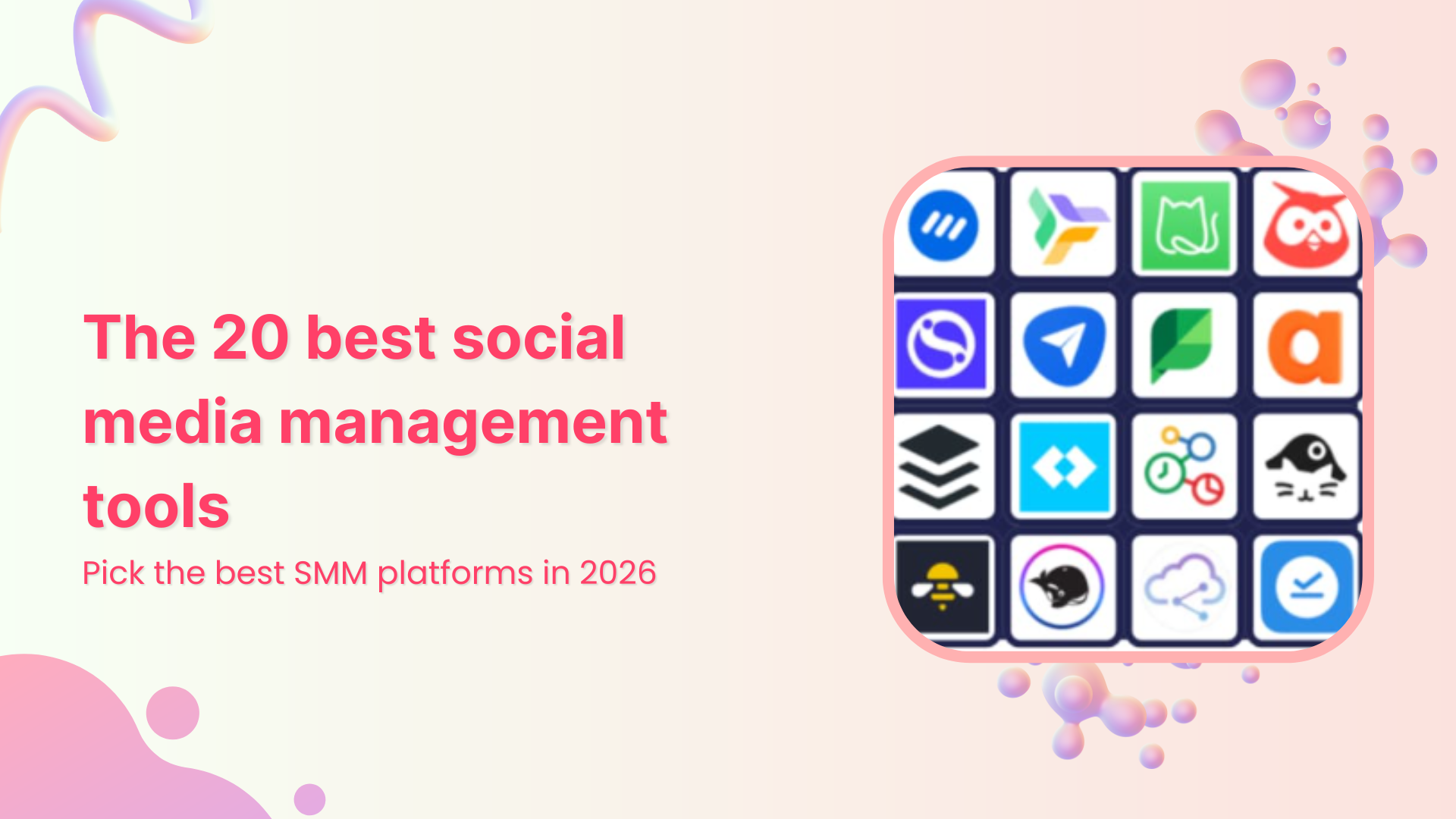Bulk-generate & schedule posts in seconds with Smart Scheduling. Try now!
Top 16 AI tools for social media for your brand
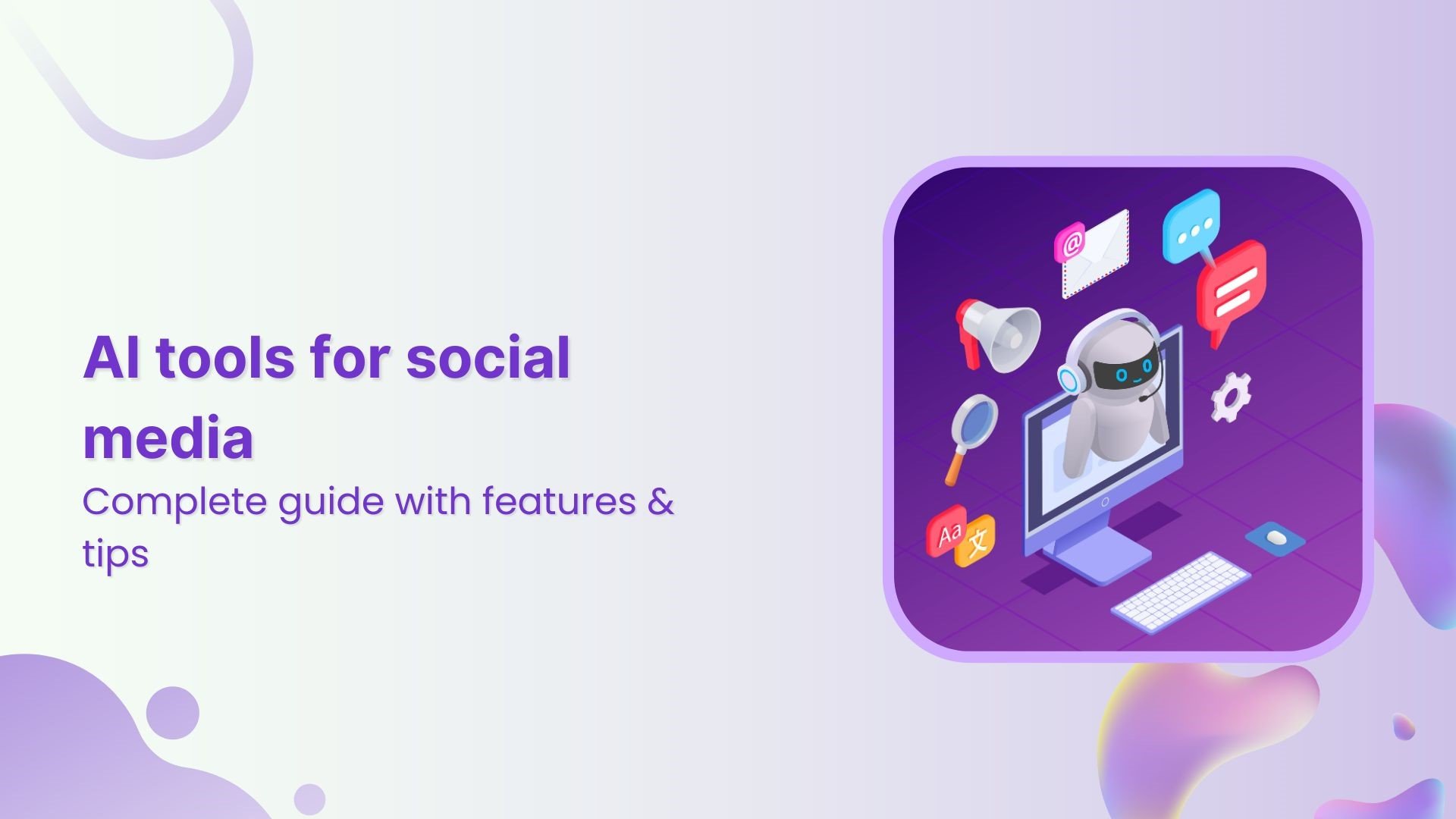
AI tools for social media are no longer optional but essential for brands that want to stay competitive. With 5.24 billion social media users worldwide, managing multiple platforms while creating engaging content has become impossible without automation.
The social media landscape moves fast. One viral TikTok trend can shift your entire content strategy overnight, and keeping up manually? That’s like trying to catch lightning in a bottle while blindfolded.
This guide breaks down everything you need to know about AI-powered social media tools, from content creation to analytics, so you can make informed decisions for your brand.
What are AI tools for social media?
AI tools for social media are software applications that use artificial intelligence to automate, enhance, or optimize various aspects of social media marketing. These tools can generate content, schedule posts, analyze performance, monitor brand mentions, and even create visual assets.
Think of them as your digital marketing team that never sleeps, never takes coffee breaks, and volunteers to work even on weekends.
These tools range from simple scheduling platforms with basic AI features to comprehensive suites that handle everything from content ideation to advanced analytics. They’re designed to solve the biggest pain points in social media marketing: time constraints, content consistency, and data analysis.
How is AI transforming social media marketing?
Social media marketing has evolved from posting random updates to a sophisticated, data-driven discipline. AI is the engine driving this transformation, making it possible for brands to compete at scale.
The shift is dramatic. Where marketers once spent hours crafting individual posts, AI can now generate dozens of variations in minutes. Where teams struggled to track mentions across platforms, AI monitors everything in real time.
But here’s the thing—AI isn’t seeking to replace human creativity but amplify it. The best social media strategies combine AI efficiency with human insight, creating content that’s both scalable and authentic.
Also Read: AI social media campaigns 2025: Best tools & strategies
Key AI technologies powering social media tools
Machine Learning Algorithms: These learn from your past content performance to predict what will work best for your audience. They get smarter over time, adapting to changes in engagement patterns.
Natural Language Processing (NLP): This technology understands and generates human-like text, powering everything from chatbots to content creation tools.
Computer vision: AI can now analyze images and videos to understand context, identify objects, and even generate visual content from text descriptions.
Predictive Analytics: By analyzing previous data and current trends, AI can forecast optimal posting times, content types, and audience preferences.
What makes the best AI tools for social media?
Not all AI social media tools are created equal. The best ones share specific characteristics that separate them from the crowded marketplace.
Advanced data analytics
Top-tier AI tools don’t just show you vanity metrics but also provide actionable insights. They can identify which content drives actual conversions, not just likes and shares.
The best analytics go beyond basic engagement rates. They track customer journey stages, identify high-value audience segments, and correlate social media activity with business outcomes.
Social Media Analytics
Fine-tune your social media strategy for success with in-depth analytics and white-labeled reports.
Get Started for FREE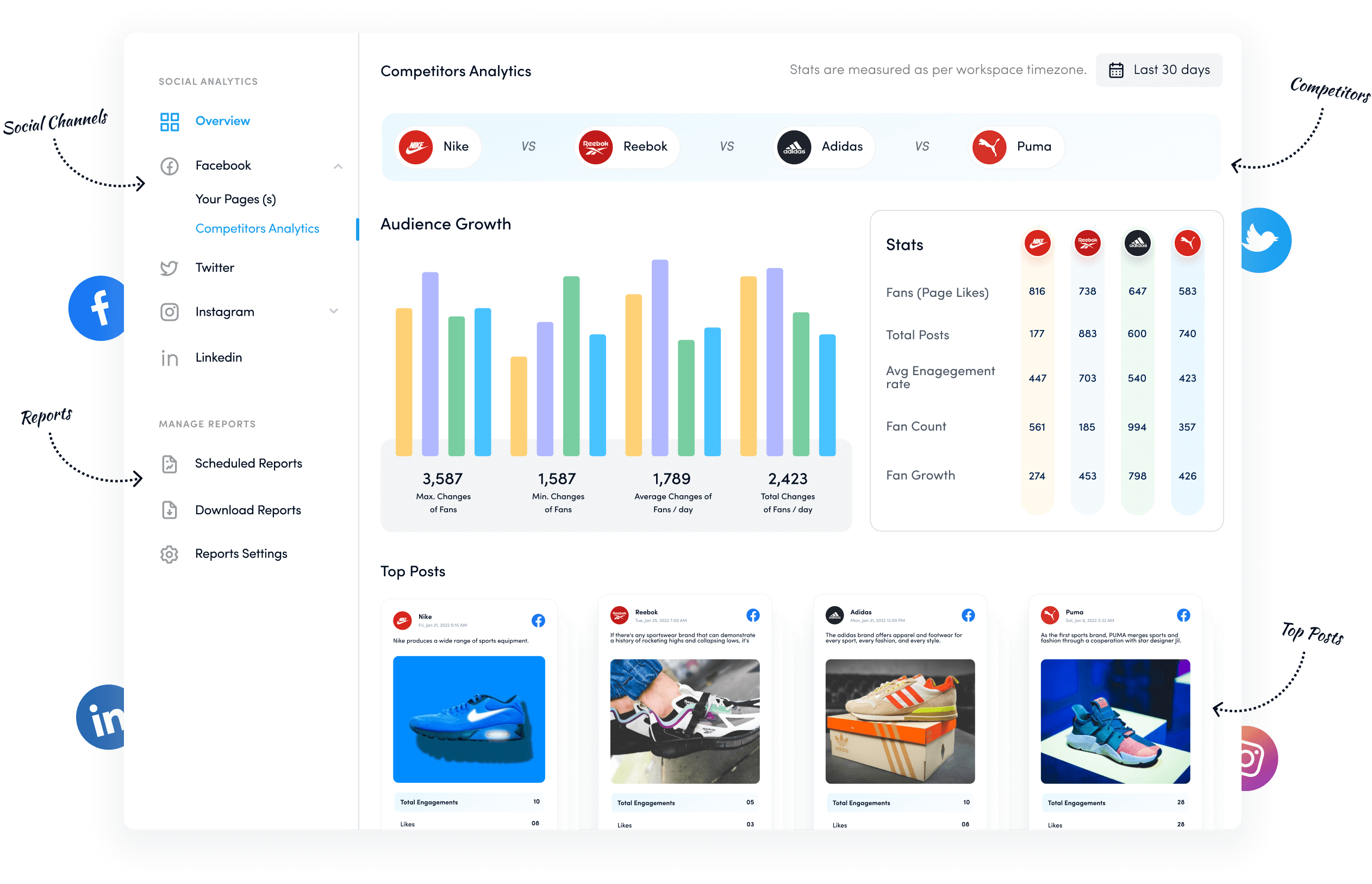
Natural language processing (NLP)
Sophisticated NLP capabilities allow tools to understand context, tone, and intent. This means they can generate content that matches your brand voice and responds appropriately to customer inquiries.
Advanced NLP also powers sentiment analysis, helping you understand not just what people are saying about your brand, but how they feel about it.
Automated content scheduling
Smart scheduling goes beyond posting at predetermined times. The best tools use AI to identify optimal posting windows based on when your specific audience is most active and engaged.
This includes cross-platform optimization, ensuring your content is formatted and timed appropriately for each social network’s unique algorithm and user behavior patterns.
Image and video generation
AI-powered visual content creation has reached impressive levels of sophistication. Tools can now generate professional-quality images, videos, and graphics from simple text prompts.
This capability is particularly valuable for brands that need consistent visual content but lack extensive design resources.
Social listening and sentiment analysis
Advanced social listening tools use AI to monitor millions of conversations across platforms, identifying trends, brand mentions, and sentiment shifts in real-time.
The best tools can distinguish between sarcasm and genuine praise, identify emerging issues before they become crises, and spot opportunities for brand engagement.
Personalized recommendations
AI analyzes audience behavior to suggest content topics, optimal posting times, and engagement strategies tailored to your specific audience segments.
These recommendations become more accurate over time as the AI learns from your audience’s responses and engagement patterns.
How to choose the best AI social media tool for your brand
Selecting the right AI social media tool requires matching your specific needs with available features. There’s no one-size-fits-all solution, despite what sales pages might claim.
Matching features to your marketing goals
Start with your objectives. Are you focused on content creation, audience growth, customer service, or analytics? Different tools excel in different areas.
If you’re primarily creating content, prioritize tools with strong AI writing and visual generation capabilities. For community management, look for advanced social listening and automated response features.
Integrations with existing platforms
Your AI tool should play nice with your current tech stack. Check for integrations with your CRM, email marketing platform, design tools, and analytics software.
Seamless integrations prevent data silos and ensure your social media efforts align with broader marketing initiatives.
Scalability and team collaboration features
Consider your team structure and growth plans. Tools should support multiple users, approval workflows, and role-based permissions.
Scalability isn’t just about user limits; rather, it’s about handling increased content volume, more platforms, and growing data requirements.
Analytics and reporting capabilities
Look for tools that provide detailed performance metrics aligned with your business goals. The ability to create custom reports and dashboards is crucial for demonstrating ROI.
Advanced tools should offer predictive analytics and recommendations based on performance data.
Cost vs. feature comparison
Price shouldn’t be your only consideration, but it matters. Calculate the true cost, including setup time, training requirements, and potential productivity gains.
Consider starting with basic plans and upgrading as you identify which features provide the most value for your specific use case.
Also Read: The best enterprise social media management tools for 2025
16 Best AI tools for social media
Here’s a breakdown of the top AI social media tools across different categories, based on features, user feedback, and market performance.
AI social media management tools
ContentStudio

ContentStudio offers a comprehensive suite for AI-powered social media management. Its content generation capabilities use advanced AI to create posts tailored to your brand voice and audience preferences.
Key features include automated content creation, multi-platform scheduling, approval workflows for team collaboration, white-label options for agencies, and detailed analytics. The platform integrates with major social networks and provides bulk scheduling capabilities.
The AI content generator analyzes your existing posts to maintain consistency while suggesting improvements based on performance data. Its automation features can handle routine posting while preserving opportunities for real-time engagement.
Its many AI features also include hashtag generation, caption generation, AI media library, and performance predictions. The platform offers an innovative social box allowing you to handle all your community communications from one place.
Sprout Social
Sprout Social combines social media management with AI-powered insights and automation. Its Smart Inbox uses AI to prioritize messages and suggest responses. The platform’s particularly good at social listening and sentiment analysis, using AI to identify trends and brand mentions across platforms.
Its reporting features provide analytics with AI-generated insights and recommendations. It also offers optimal publishing recommendations and content performance predictions, making it valuable for data-driven social media strategies.
Buffer
Buffer’s AI assistant helps generate post ideas and optimize content for different platforms. The platform’s scheduling algorithm uses machine learning to identify optimal posting times for your specific audience.
Its analytics dashboard includes AI-powered insights that highlight top-performing content and suggest improvements. Buffer’s simplicity makes it accessible for small teams while providing enterprise-level features for larger organizations.
Later
Later specializes in visual content scheduling with AI-powered optimization features. It has a best time to post feature that uses AI to analyze your audience’s engagement patterns. The platform’s visual content calendar makes it easy to plan and preview your social media presence.
Later’s strength lies in Instagram and Pinterest marketing, with specialized features for visual content optimization and influencer collaboration management.
AI content creation tools
Jasper
Jasper (formerly Jarvis) is a powerful AI writing tool that excels at creating social media content. It can generate posts, captions, and ad copy across different platforms and formats.
The platform includes templates specifically designed for social media marketing, from Instagram captions to LinkedIn posts. Jasper’s Brand Voice feature ensures consistency across all generated content.
Advanced features include content optimization for different platforms, tone adjustment, and integration with popular social media management tools.
Zeely AI
Zeely AI is a powerful AI-driven social media ad creation and campaign automation platform that empowers brands to produce high-performing video and static ads in minutes — no design or video editing skills required. Built for speed, scale, and social-first performance, Zeely transforms your product data into conversion-ready ads optimized for platforms like Instagram, TikTok, Facebook, and more.
Perfect for eCommerce and DTC brands, Zeely combines AI avatars, smart scripting, and creative automation to help businesses stand out in competitive social feeds, drive engagement, and scale ad performance across channels.
Copy.ai
Copy.ai offers AI-powered copywriting specifically designed for marketing applications. Its social media templates can generate content for various platforms and campaign types.
The platform’s strength lies in its ability to generate multiple variations of content quickly, allowing for extensive A/B testing. Its workflow features enable team collaboration and content approval processes.
Copy.ai’s integration capabilities allow direct publishing to major social platforms, streamlining the content creation-to-publication process.
Writesonic
Writesonic provides AI content generation with a focus on conversion optimization. Its social media tools can create posts designed to drive specific actions, from engagement to website visits.
The platform includes advanced features like competitor analysis, trending topic identification, and performance prediction. Its AI can adapt content tone and style based on platform requirements.
Writesonic’s bulk generation capabilities make it suitable for agencies and larger organizations managing multiple client accounts.
StoryLab.ai
StoryLab.ai specializes in AI-powered creative content for social media marketing. Its tools focus on generating engaging, story-driven content that resonates with audiences.
The platform excels at creating content series, campaign narratives, and brand storytelling elements. Its AI understands narrative structure and can maintain consistency across multi-post campaigns.
StoryLab.ai’s unique approach to content creation makes it valuable for brands prioritizing authentic storytelling and emotional connection.
AI image and video tools
Canva
Canva has now integrated AI into its design platform, making professional visual content accessible to non-designers. Its Magic Resize feature automatically adapts designs for different social platforms.
AI features include background removal, image enhancement, and automated design suggestions. Its brand kit feature ensures consistency across all visual content, while AI recommendations help optimize designs for engagement.
Canva’s template library combined with AI customization creates endless possibilities for social media visuals.
Freepik
Freepik AI tools offer a robust creative platform built to speed up and elevate content creation for social media. It combines multiple AI-driven tools into one unified experience, helping users design, edit, and publish in minutes.
Designed for simplicity and performance, it eliminates the need to jump between apps. The AI Suite includes tools like Freepik AI Image Generator, AI Video Generator, Background Remover, Image Upscaler, and many more. From solo creators to brand account managers, this suite ensures content is always fast, professional-looking, and on-brand.
Predis.ai
Predis.ai focuses specifically on AI-generated social media content, including both text and visuals. The platform can create complete social media posts with matching graphics and copy.
Its AI analyzes current trends and competitor content to suggest relevant topics and visual styles. The platform supports multiple languages and can adapt content for different cultural contexts.
Predis.ai’s end-to-end content creation makes it efficient for businesses managing multiple social media accounts.
Lumen5
Lumen5 transforms text content into engaging videos using AI. The platform can convert blog posts, articles, or simple text into professional-quality social media videos.
Its AI selects relevant stock footage, applies appropriate transitions, and even suggests music to match the content tone. Custom branding options ensure videos align with your brand identity.
Lumen5’s automated video creation makes it possible to maintain a consistent video presence without extensive production resources.
Synthesia
Synthesia creates AI-generated videos featuring realistic human avatars. This technology is particularly useful for brands creating educational content, product demonstrations, or personalized messages.
The platform offers multiple avatar options and supports numerous languages, making it valuable for global brands. Custom avatar creation allows brands to develop unique spokesperson personas.
Synthesia’s technology eliminates traditional video production constraints while maintaining professional quality and authenticity.
AI tools for social listening and brand perception
Brandwatch
Brandwatch provides comprehensive social listening powered by advanced AI analytics. The platform monitors millions of online conversations, identifying trends, sentiment, and brand mentions.
AI features include emotion detection, influencer identification, and crisis prediction. Its analytics dashboard provides actionable insights for brand management and marketing strategy development.
Brandwatch’s enterprise-level capabilities make it suitable for large organizations requiring sophisticated social intelligence and competitive analysis.
Brand24
Brand24 offers real-time social media monitoring with AI-powered sentiment analysis and mention prioritization. The platform tracks brand mentions across social networks, blogs, forums, and news sites.
Its AI can distinguish between different types of mentions, identifying potential customers, detractors, and brand advocates. Automated alerts ensure immediate response to important mentions or emerging issues.
Brand24’s user-friendly interface makes advanced social listening accessible to businesses of all sizes.
Dash Social
Dash Social combines social listening with competitive intelligence, using AI to analyze market trends and competitor strategies. Its platform provides insights into audience preferences and content performance across industries.
AI features include trend prediction, audience analysis, and content optimization recommendations. The platform’s reporting capabilities help brands understand their position in the competitive landscape.
Dash Social’s focus on actionable intelligence makes it valuable for strategic planning and campaign optimization.
Best practices for using AI tools for social media
Implementing AI tools effectively requires strategic thinking and careful execution. Think of them as really smart interns that can do amazing work but still need proper training and supervision. Here’s how to get the best results without accidentally letting a virtual robot ruin your brand reputation.
Maintaining brand voice and authenticity
Your brand voice is what makes you unique, and AI shouldn’t flatten that into generic corporate speak. It should amplify your voice, not change it. Feed it examples of your best content so it learns your style and tone, whether that’s witty but heartfelt storytelling or straightforward formal expertise.
Set up regular content audits like you would check a new employee’s work. AI might get your tone right 90% of the time, but that 10% could be the difference between “relatable brand” and “trying too hard millennial energy.” Create clear brand guidelines that AI can follow, and then stick to them religiously.
Human oversight and quality control
AI tools are brilliant, but they’re also capable of spectacular fails. Remember when AI chatbots started agreeing with everything, including completely wrong information? Yeah, we don’t want that energy for your brand. Learn to fact-check everything AI tools put out.
Build review processes that catch issues before they go live, especially for anything controversial or customer-facing. Your AI might miss cultural nuances, current events context, or just plain common sense. Human reviewers catch the stuff that could turn a simple post into a PR nightmare.
Data-driven content strategy development
AI analytics can pick up on engagement patterns you may not quite catch on to. They can tell you if your audience prefers questions better than polls or if your Wednesday carousel is performing better than your Thursday reel.
The key is to use AI analytics to inform your content strategy while not letting the data override creative instincts entirely. After all, the best strategies combine AI insights with human creativity and strategic thinking.
Don’t hesitate to explore and experiment with your content strategy to keep it fresh. AI insights might make you inclined to follow those patterns, but stepping out of the box every now and then can bring over a new audience and engagement.
Balancing automation with personal touch
Automation is perfect for the mundane tasks such as scheduling posts, filler content, or basic customer service responses. But the moment someone needs actual help or wants to have a real conversation, that’s human territory.
Let’s put it this way: AI handles the logistics so humans can focus on building relationships. Your followers can tell the difference between a bot response and genuine human interaction, so use each where they shine brightest in your customer care strategy.
The ultimate goal is to enhance efficiency without losing the personal connection that drives social media engagement and loyalty.
Benefits of using AI tools for social media marketing
AI tools are pretty much the sous-chefs to social media managers; they do the chopping, prepping, and plating, but you’re still running the kitchen. Here are some ways they benefit social media marketers:
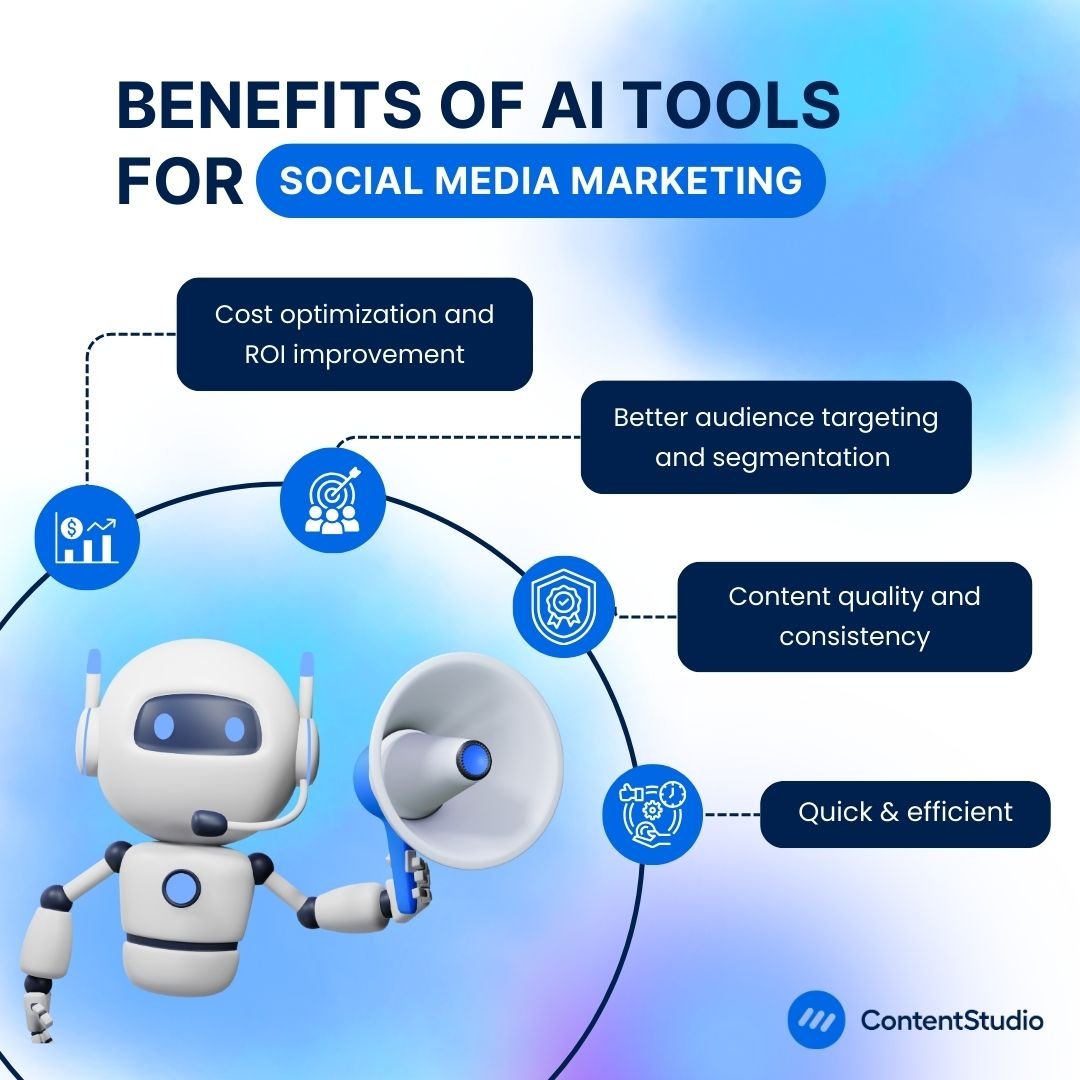
Increased efficiency and time savings
Remember when creating a week’s worth of social content took an entire day? AI tools can slash that time well enough to turn your content creation marathon into a quick sprint with enough time for you to make coffee runs to the other side of the block.
Your team can finally focus on what humans do best, i.e., strategic thinking and genuine community building and engagement, instead of wrestling with caption variations at 11 PM.
The beauty lies in the learning curve. These tools get smarter about your preferences over time, requiring less hand-holding as they go. But here’s the catch: garbage in, garbage out. Poorly set up AI tools can actually create more work through inconsistent outputs and embarrassing mistakes.
Enhanced content quality and consistency
AI doesn’t have off days. It doesn’t get writer’s block or forget your brand guidelines after a long weekend. While your human team might struggle with maintaining voice consistency across 50 posts per week, AI keeps everything on-brand and error-free.
The real power move here is that AI can also analyze your top-performing content and reverse-engineer what made it successful. It’s like having a data scientist dedicated to cracking your engagement code and then applying those insights to future posts automatically.
Improved audience targeting and engagement
AI sees patterns humans miss entirely. It notices that your audience engages 23% more with carousel posts on Tuesday afternoons or that certain color schemes drive more saves.
The personalization capabilities are where things get interesting. AI can segment your audience and tailor content for different groups simultaneously. Your Gen Z followers get memes, your millennial audience gets nostalgia content, and your Gen X segment gets practical tips—all from the same campaign brief.
Cost optimization and ROI improvement
Here’s where the spreadsheet lovers get excited. AI tools typically pay for themselves within months by reducing the need for extensive creative teams and speeding up production cycles. You’re not eliminating human creativity but instead amplifying it.
The math is simple: lower cost per post plus higher engagement rates equals better ROI. But don’t fall into the trap of buying the fanciest enterprise tool if you’re running a small operation or choosing the cheapest option when you need serious firepower. Match the tool to your actual needs, not just your aspirations.
Conclusion
Whether you’re a newbie startup or an enterprise giant, there’s an AI solution that fits your budget and ambitions. The secret is in combining AI’s efficiency with genuine human creativity and oversight.
The tech landscape moves fast; a good social media manager moves with it. Explore and test new tools, and remember that the brands crushing it on social media right now are the ones using AI as their creative sidekick, not their replacement for authentic human connection.
FAQs
What is the best AI tool?
The best AI tool for social media depends on your specific needs, budget, and team size. ContentStudio excels for comprehensive management, Jasper for content creation, and Brand24 for brand monitoring. Evaluate tools based on your primary use case and growth plans.
How is AI used in social media?
AI powers multiple aspects of social media marketing: content generation, scheduling optimization, audience analysis, sentiment monitoring, and performance prediction. It can automate routine tasks and provide insights that inform strategy decisions.
What are the top AI tools for social media management?
The leading AI social media management tools include ContentStudio for comprehensive management, Sprout Social for enterprise features, Buffer for simplicity and effectiveness, and Later for visual content focus. Choose based on your platform preferences, team size, and feature requirements rather than popularity alone.
Recommended for you


Powerful social media management software
14-day free trial - No credit card required.

